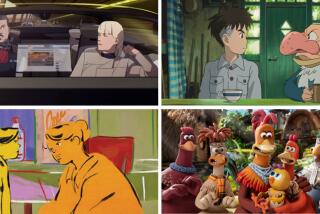From the page to the screen
- Share via
LITERARY adaptations are often perilous ventures as filmmakers struggle to retain the important elements of the source while creating something that works on its own as a film. Two underappreciated films by Frank Perry, matched as part of the American Cinematheque’s Return to New Hollywood series, illustrate the fragility of adapting sophisticated works.
Based on Joan Didion’s novel, “Play It as It Lays” (1972) stars Tuesday Weld as the luminously numb model-turned-actress Maria Wyeth. Maria -- with a long “i” -- is the unhappy wife of a director (Adam Roarke), and she’s had just about enough of their life in the fast lane and the institutionalization of their daughter.
Maria’s best friend is a closeted producer named B.Z., played with wonderfully morose amusement by Anthony Perkins. All the parties, all the beautiful people and all the alcohol have failed to stem the flow of ennui for them. Maria and B.Z. have stopped asking questions, stopped caring, because the answer is always the same: nothing.
Perry’s corrosive L.A. looks like an automotive ant farm via aerial shots of the freeway system’s creepy, crawling interchanges. The bright, smog-filtered sun casts the right post-nuclear glow as Maria and B.Z. slide from the scene. Didion and husband John Gregory Dunne wrote the screenplay, which maintains the book’s unsettling tone.
Four years earlier, Perry directed “The Swimmer,” wife Eleanor Perry’s adaptation of the frequently anthologized John Cheever short story. Burt Lancaster starred as Ned Merrill, a middle-aged ad man who sets out one Sunday afternoon to swim home across the lush Connecticut countryside, one pool at a time.
The greetings Ned receives from his suburban neighbors cool as the afternoon wanes and he encounters former friends and ex-lovers. Lancaster, wearing only a swimsuit, projects a remarkable physical transformation, from virile stallion to fallen Adonis, as the story unfolds with the same bitter tragedy as Cheever’s story. The Marvin Hamlisch score is overbearing at times, and some of the film’s flights of fancy work against the subtlety, but it’s a surprisingly successful take on what might be labeled an “unadaptable” piece of literature.
In order to get the film made, Perry ceded creative control to producer Sam Spiegel, who reportedly had an uncredited Sydney Pollack do reshoots. The resulting film received a chilly reception from many critics but has grown in stature.
Early animation
The intersection of printed comics and motion pictures is explored in Comic Art Onscreen at UCLA. The triptych of animation from the silent and early sound eras -- including the work of pioneer Winsor McCay, eccentric social commentaries and early appearances by two famous felines -- delivers a diverse view of period styles.
McCay, a celebrated newspaper cartoonist, animated 4,000 drawings for “Little Nemo,” which debuted in 1911 and was used in the artist’s vaudeville routine. Characters from the comic strip come to life, gleefully taunting the audience with their newfound ability to move. By 1914, McCay’s “Gertie the Dinosaur” would be asserting her unique persona on screen, rising up from the water and chomping trees with astonishingly detailed bites. McCay’s “Dreams of a Rarebit Fiend: Bug Vaudeville” and a fragment from “The Centaurs,” both from 1921, also screen.
Various filmmakers contribute to “This Cartoon Life,” a humorous assortment of vignettes on contemporary social mores. “Breath of a Nation” (1919), an amusing spoof on the evils of drink based on a comic by Thomas A. Dorgan, was directed by Gregory La Cava, who went on to a distinguished live-action career, including “My Man Godfrey” and “Stage Door.” Also based on a Dorgan comic is William C. Nolan’s “Indoor Sports” (1921). “The Beer Parade” (1933) by Dick Huemer and two of Earl Hurd’s “Bobby Bumps” cartoons (1916 and 1917), based on R.F. Outcault’s “Buster Brown” comics, round out the section.
Three early appearances by Krazy Kat and two Felix the Cat vehicles comprise the “Feline Follies” segment. “Krazy Kat Goes A-Wooing” and “Krazy Kat and Ignatz Mouse at the Circus,” both from 1916 and featuring Krazy’s odd affection for his “darlink” rodent friend, are contrasted with a later interpretation of George Herriman’s furry creation in 1930’s “The Apache Kid.” “Felix the Cat in Blunderland” and “Felix the Cat Weathers the Weather,” both from 1926, also screen.
On March 11, a second program of Comic Art Onscreen will feature Oshima Nagisa’s 1967 “Band of Ninja.”
*
Screenings
Frank Perry Tribute
* “Play It As It Lays” and “The Swimmer”: 7:30 p.m. Wednesday
Where: Aero Theatre, 1328 Montana Ave., Santa Monica
* Also, 7:30 p.m. March 17
Where: Lloyd E. Rigler Theatre at the Egyptian, 6712 Hollywood Blvd., Hollywood
Info: (323) 466-FILM, www.egyptiantheatre.com
Comic Art Onscreen
* “Winsor McCay,” “This Cartoon Life” and “Feline Follies”: 7:30 p.m. Friday
Where: James Bridges Theater, Melnitz Hall, UCLA
Info: (310) 206-FILM, www.cinema.ucla.edu
More to Read
Only good movies
Get the Indie Focus newsletter, Mark Olsen's weekly guide to the world of cinema.
You may occasionally receive promotional content from the Los Angeles Times.









